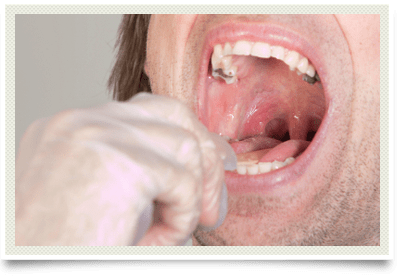
Oral Cavity
and Throat Conditions
Although the teeth are the domain of the dental profession, many patients consult an otolaryngologist for clinical problems related to the tongue and oral cavity (mouth). This page details many of the oral cavity and throat conditions managed by Dr. Gregg Govett.
- Tongue:
The tongue can be affected by trauma, tumor, inflammation, or infectious agents. The sensation of taste is derived from taste buds, the majority of which are located on the anterior tongue. Biopsies and other laboratory evaluations are needed to confirm the pathology. Management is based on the pathology present. - Mucous Membranes:
The lining of the mouth or the mucous membranes of the oral cavity are subject to a variety of infectious, inflammatory, traumatic, and neoplastic insults. Rarely, biopsies or other laboratory evaluations are needed to confirm the pathology. As with the tongue, management is based on the pathology present. - Tonsils / Adenoids:
Tonsils are masses of lymphoid tissue located in the throat on the sides of the tongue and are often the source of recurrent streptococcal infections. The tonsils can simply be enlarged without infections and cause swallowing and snoring/sleep apnea problems.
The adenoids are the lymphoid tissue located behind the nose between the Eustachian tube openings in the nasopharynx. The adenoids have a strong relationship with ear disease and are often surgically removed when ear tube are placed for ear infections. These surgical procedures are performed in an outpatient surgery center. - Snoring / Obstructive Sleep Apnea:
Snoring is simply loud breathing usually caused by vibrations of the soft palate during sleep. It can result in a domestic disturbance due to one partner's sleep being interrupted due to the noise generated from the snoring.
Obstructive sleep apnea (OSA) is a cessation of breathing during sleep resulting from a temporary blockage in the airway. OSA is a medical condition that over time can generate significant damage to the heart, lung, and vascular system. It can also result in the premature death of the patient.
It is initially evaluated by an examination to include a flexible fiberoptic laryngoscopy and a polysomnogram (sleep study) in a sleep laboratory. Continuous Positive Airway Pressure (CPAP) is the initial form of management that requires a face mask or nasal pillow inserts. The pressure setting is determined in a sleep laboratory along with the type of delivery device that best treats the apnea. An otolaryngologist should be consulted for problems related to snoring and sleep apnea as he/she has the necessary equipment to evaluate the patency of the airway prior to initiation of the CPAP.
If the airway is found to be compromised by a deviated septum, nasal polyps, hypertrophic turbinates, enlarged tonsils/adenoids, or other lesions in the throat, the CPAP will not be effective until the airway obstructions are removed. In the past, the uvulopalatopharyngoplasty surgical procedure (removal of the tonsils, uvula, and part of the soft palate) was the main treatment of OSA. However, due to the high rate of failure over time, this procedure has been relegated to enlargement of the airway to facilitate CPAP use. Septoplasty with or without turbinate reduction is also used to improve the nasal airway to allow for more productive CPAP usage. - Laryngopharyngeal Reflux:
Reflux of stomach acid into the larynx and hypopharynx occurs up to four times per day in most humans. When this problem becomes pathologic, patients can suffer from chronic sore throats, hoarseness, dysphagia (problems swallowing), throat phlegm, chronic throat clearing, and chronic coughing.
Dr. Govett takes this problem very seriously as gastroesophageal reflux (GERD) has been shown to be the etiology of cancers in the larynx, hypopharynx, and esophagus. The larynx and hypopharynx are evaluated in the office with the flexible laryngoscope; management of this problems is based on medication and diet.
In difficult cases, it can be helpful to perform food evaluation to see what food may be causing the problem (see environmental medicine section). Patients may need to be referred to a gastroenterologist for an esophagogastroduodenoscopy (EGD) to evaluate the esophagus, stomach, and initial part of the small intestine for pathology. - Dysphonia:
Dysphonia (hoarseness) is any impairment in the ability to speak normally. It is evaluated with the flexible fiberoptic laryngoscope in the office exam chair. It can result from a variety of medical conditions. However, microsurgery is needed to remove polyps and perform biopsies on suspicious vocal cord lesions in the outpatient surgery center.
If a true vocal cord paralysis is found on the examination, CT scans of the chest and neck are ordered to evaluate the course of the nerve that innervates the vocal cords. If the paralysis is related to surgical procedures, a 9-12 month period of clinical observation is used to allow for neurologic recovery. If problems with dysphonia, weak cough, and dysphagia are present with the permanent vocal cord paralysis, a medialization procedure on the affected vocal cord is performed in an outpatient surgery center under local anesthesia to correct the problem. - Dysphagia: Dysphagia, or problem/difficulty swallowing, is a common condition that results in an otolaryngology consultation. It is evaluated with the flexible fiberoptic laryngoscope in the office and often radiographic contrast studies are used. Management is based on the clinical and radiographic findings.
- Cancers of the Oral Cavity and Throat:
Cancers in this region are fortunately rare but are seen in the office of Dr. Govett about 6-8 times per year. These cancers require a biopsy for pathologic confirmation along with CT or PET scanning. Due to the size of these tumors at presentation, robotic surgical procedures are often needed for removal along with postoperative radiation. These clinical problems are usually referred to due to their complexity.
